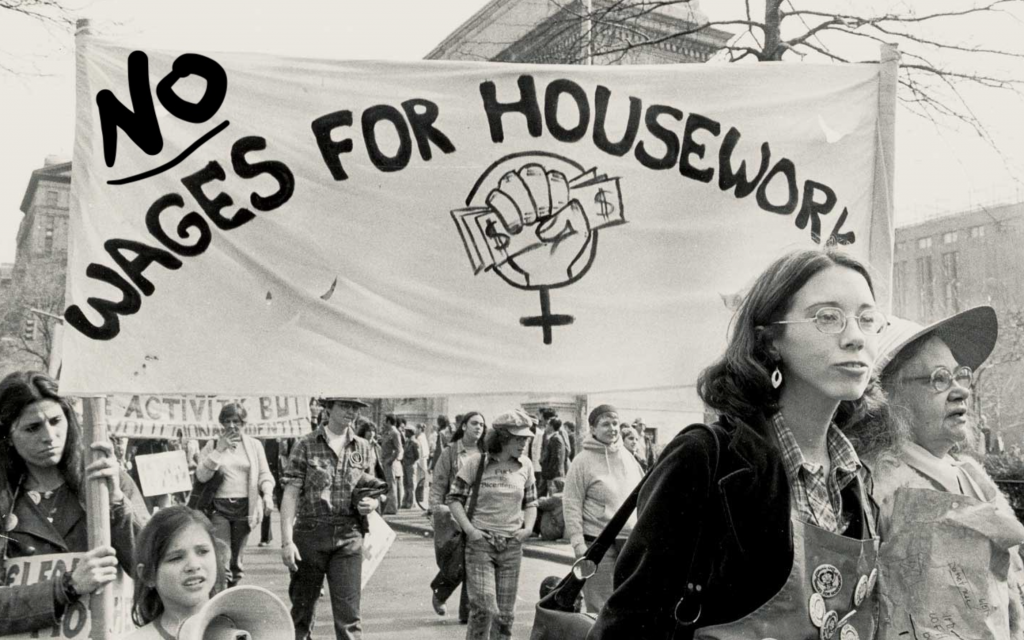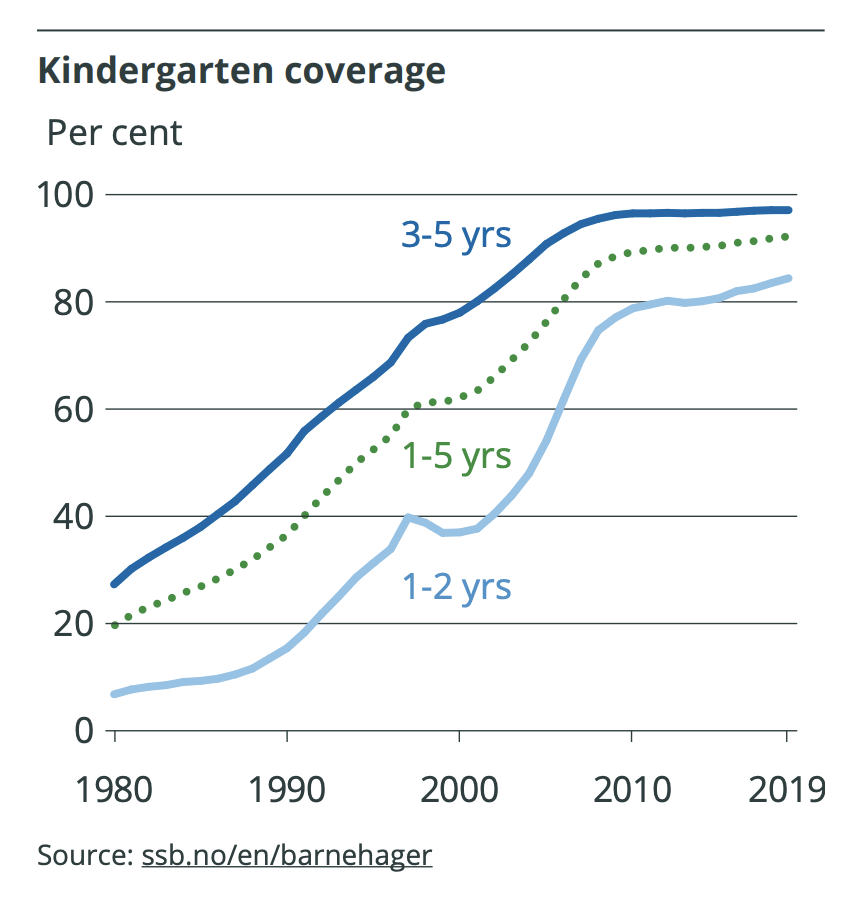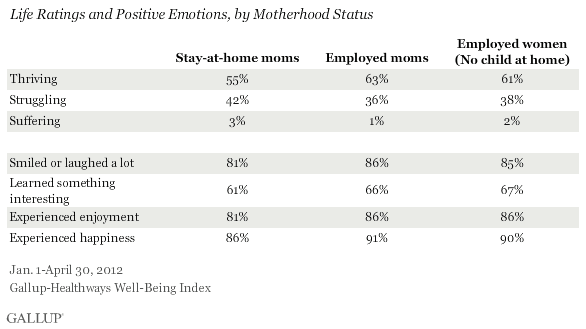
On Saturday, I published a piece in the New York Times arguing that, as states expand child care benefits in the coming years, they should provide benefits both to people who use child care services and to home caregivers. I wrote something similar in my 2019 child benefits paper “Family Fun Pack.”
Of course, I did not originate this idea. It has a long intellectual history, especially among socialist feminists like Crystal Eastman (co-founder of the Women’s International League for Peace and Freedom and the American Civil Liberties Union) and Silvia Federici, Mariarosa Dalla Costa, and Selma James (co-founders of International Wages for Housework Campaign).
The idea has also been implemented in a number of countries across the world, including all four Nordic nations at various points.
Today, Jill Filipovic attacked the idea as sexist in a bizarre piece that reads more like a big vent about stay-at-home moms than it does a serious policy critique. Before getting into Filipovic’s article, it’s useful to lay out a few clarifying points about the policy being proposed, points that will come up over and over again in the text below.
- In the proposal, parents with children below the age of 3 get to choose between free (or heavily subsidized) child care services or a cash benefit paid to them for their home child care. Nobody is required to do one or the other and parents can switch from one to the other if they change their mind.
- The studies show that home child care benefits do not affect child care decision-making very much. The vast majority of people who do home child care will do it regardless of whether it is paid. This means that home child care benefits primarily determine whether home child carers are paid not whether parents choose it over child care services.
With that out of the way, let’s see what Filipovic has to say.
Bruenig argues that this is all about choice. The problem, though, is that culture and inequality influence our options and shape our choices. Many women who technically “choose” to stay home likely would have made very different choices if they had a supportive partner who pulled his weight around the house and with the kids, or if they had a stable job with reasonable and predictable hours, or if they weren’t underpaid from having kids in the rst place, or if they knew that down the line they would wind up divorced or widowed, or if they had a fuller picture of the mental health costs of leaving the labor force.
It’s true that people develop preferences and make choices within material and cultural constraints. For instance, if our culture did not associate labor market success with personal worth, some people who currently prefer working over home child care would likely have the opposite preference. Similarly, if our society was less sexist in the way that it associates male labor market success with male personal worth, more men would likely prefer home child care than do currently.
But what does this have to do with the policy in question? Remember from (2) above that the option of a home child care benefit does not affect child care decision-making very much. What is gained by providing these home carers (who are mostly women) $0 of personal income?
Also remember from (1) above that the policy in question allows people the option of free (or heavily subsidized) child care services or a home care benefit, a choice that they can change at any time, such as when cultural norms change.
We can see this play out very clearly in the case of Norway. Starting in 1998, parents had the option of home child care or free/subsidized child care for ages 1 and 2. As preferences evolved over the years, more people have chosen child care over home care and kindergarten coverage for this age group rose from 40% in 1998 to around 85% in 2020.

Filipovic’s point simply has no relevance to the policy question at hand.
Next Filipovic makes a very handwavey claim that a home care benefit reinforces bad ideas in society.
Creating incentives for mothers to stay home, even if those incentives are gender-neutral on their face, reinforces the idea that women are and should be the primary caretakers of children, and that affects everyone — not just the women who choose to stay home
This is a funny quote because it seems to imply that Filipovic would be OK if men were able to receive home child care benefits, but not women (who knows about queer and non-binary parents, which Filipovic ignores entirely throughout her piece).
But putting that bit of humor aside, there is simply no basis to this claim. In fact, all of her grievances on this front are about cultural phenomena in America where no such benefit exists!
And when it comes to reinforcement, one has to wonder what we are reinforcing in our culture when we say that parents (primarily women) who do home child care, which is absolutely essential for the functioning of the economy and social reproduction, should get paid nothing for their work. If you don’t want to devalue women in your society, you probably should avoid valuing home child care at $0.
One also has to wonder how exactly Filipovic’s alternative to home care, which is child care services, is any different in this regard. The child care sector is almost entirely staffed by women, disproportionately women of color and immigrants with low levels of education. What does this “reinforce” in our culture? That child care is properly done by the lower class women of society? How inspiring.
Finally, remember point (2) above, which is that the existence of the benefit does not actually have a huge impact on how many people do home care. You can keep these parents penniless but you can’t force them to use child care services.
Moving on, here is Jill’s next point:
Dropping out of the workforce also leaves women financially and physically vulnerable. Bruenig’s suggested childcare stipend would put a little money into the pockets of stay-at- home mothers (or into bank accounts primarily controlled by their husbands) for a short period of time, but it would not compensate for the years of experience lost, nor make it easier to get back into the paid workforce after years away. It wouldn’t make up for the permanent wage decrease, or the hit to retirement savings and social security.
Not paying home child carers (as Jill prefers) clearly and obviously leaves women more financially and physically vulnerable than paying them. Indeed, protecting home child carers against the vulnerability of working unpaid and thus relying on their partner’s income is one of the primary arguments for the program.
Here is Crystal Eastman making this point in 1920 in the socialist Liberator magazine:
But is there any way of insuring a woman’s economic independence while child-raising is her chosen occupation? Or must she sink into that dependent state from which, as we all know, it is so hard to rise again? That brings us to the fourth feature of our program — motherhood endowment. It seems that the only way we can keep mothers free, at least in a capitalist society, is by the establishment of a principle that the occupation of raising children is peculiarly and directly a service to society, and that the mother upon whom the necessity and privilege of performing this service naturally falls is entitled to an adequate economic reward from the political government. It is idle to talk of real economic independence for women unless this principle is accepted.
Jill’s parenthetical about home child care benefits going “into bank accounts primarily controlled by their husbands” is truly bizarre. If the husband is controlling the bank account, then all sources of income, including wages from work, which are also deposited into a bank account, provide you no independence, right?
As for things like retirement and Social Security, there is no reason that someone could not receive Social Security credits for the time they spend doing home child care. After all, with a home child care benefit, they are literally being paid a wage to do it.
Finally, Jill’s remarks about there being a “permanent wage decrease” and “years of experience lost” when a parent chooses to do home child care for a while and then return to the labor market reveals that, in her analysis, she is really thinking about a very specific kind of professional worker.
Lower class men and women, the population that much more often opts for home care, don’t really climb the corporate ladder over the course of their careers. Lower-level retail and service sector jobs will still be there once they finish their home care. Professional class men and women very rarely opt for home care, perhaps for the reasons given by Jill.
Next Jill moves on to claims about happiness:
Even taking finances out of it, the nuclear family breadwinner-carer model is a historical anomaly, and tremendously isolating for the carer (the mother). Stay-at-home mothers are psychologically and emotionally worse off than working mothers by just about every measure, from depression to anxiety to anger; they are much more likely than working mothers to say that they are struggling, and less likely to say that they are thriving, that they recently experienced enjoyment or happiness, that they smile or laugh a lot, and that they have learned something new.
Putting aside the silliness of using data about unpaid home caregivers to argue about the status of paid home caregivers, Jill’s own preferred data does not show that much difference between home caregivers and working mothers, and the vast majority of stay at home caregivers seem to be doing alright when judged by things like whether they experience happiness (86%), enjoyment (81%), and laughter (81%).

People like Jill love to fight the mommy wars and argue endlessly over the best way to manage children and working. But the reality is not that complicated: some people prefer home care more than working a formal job and others prefer working more than home care.
The genius of this policy design is that, by supporting both heavily subsidized child care services and a home care benefit, people are free to sort themselves into the path that they like. If you are not so happy with home care, then you are free to make use of the child care services.
Jill continues:
In giving up paid work, though, women give up more than a paycheck. We give up future security. We give up valuable social interactions that keep our interpersonal skills sharp, keep us connected to people outside of our families, stimulate our creativity, and imbue a sense of purpose in our daily lives. We give up some measure of safety: When women or children are isolated in the home — when women are out of work, when kids are kept out of school — it’s much easier for abuse to go undetected, and much harder for women living with abusive partners to identify it (often it takes someone outside of the family to emphasize that an abusive dynamic is not normal and not acceptable). And how, exactly, are women supposed to leave abusive situations if they have no money of their own and few connections outside of the family?
Let us again reiterate point number (2) above. Every argument Jill makes operates on the assumption that, in choosing whether to pay home child care, you are also choosing whether people do home care or rely on child care. This is simply not true. It has very little effect on that decision. It overwhelmingly just compensates people for something they are going to do whether paid or not.
This quote reveals again that Jill seems unable to think about people other than herself. When your job is putting on $7,000 per person yoga and writing retreats in Kenya for rich dilettantes, that probably is kind of fun and stimulating (how it gives you a sense of purpose, I don’t know). But, please believe me when I say that not all jobs are like that. Indeed, many jobs crush the creativity and purpose right out of you!
The idea that home child carers are isolated is also a weird over-generalization revealing again that Jill can only think of people in her own proximity. When I was growing up in Texas, I lived a lot of my life in a primarily lower-income Mexican area. Like many Latino and Asian immigrant neighborhoods, home care was very prevalent in the area, but this wasn’t done alone in houses. It was done quite prominently at playgrounds, libraries, and churches where Mexican-American mothers would gather and chat while their kids partook of free entertainment of various sorts. Not every community is hollowed out.
And the idea that having a job means that you aren’t isolated is also an obvious over-generalization. Plenty of people clock in and clock out without much interaction with anybody and come back home.
As with many of the other points, Jill just seems fundamentally incapable of understanding that the world is a very heterogeneous place. Some people would feel more isolated being home care givers. Others would feel more isolated being at work. It depends on the job, the way that home care is done in the surrounding culture, and personal quirks. The genius of the policy is that it allows people to sort themselves accordingly.
Finally, in this quote Jill returns back again to the bizarre argument that, by paying home child carers, you make it harder for women to leave abusive situations because they have no money of their own. The policy is literally to give them money of their own! It is Jill that wants them to have no money!
I could go on, but obviously I’ve already gone on long enough. In closing, I will just leave you with the first comment left on Jill’s post (to comment you need to be a paying subscriber to her Substack) by a sexist person named Katie.
